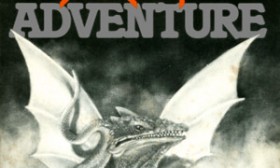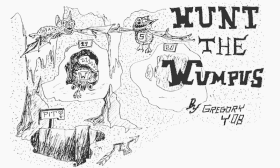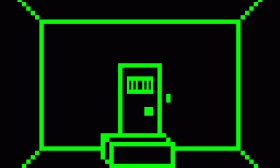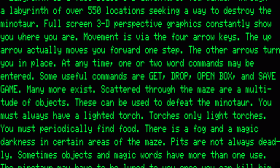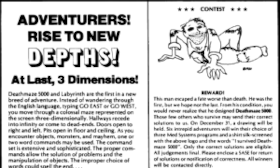Articles in the "Adventure Games" Category
Microsoft Adventure, introduced in December 1979, was the first game sold by Microsoft, Inc., which at the time was located in Bellevue, Washington. It was written by Gordon Letwin and was among the first four products sold by Microsoft Consumer Products, a new division created to sell software to consumers. Before that point, Microsoft primarily sold BASIC interpreters (such as TRS-80 Level II BASIC) directly to manufacturers. Microsoft Adventure cost $29.95 and was available for the TRS-80 Model I and the Apple II when it was released in 1979. It had unusually high system requirements for a game at the time; both the Model I and Apple II versions required 32K and a floppy drive.
Microsoft Adventure was a microcomputer adaptation of Adventure, also known as Colossal Cave or ADVENT, which was first written for the DEC PDP-10. Adventure was the first computer adventure game and became very popular on mainframe installations in 1977 and 1978.
(Read more...)
Hunt the Wumpus, also known as
Wumpus 1 or simply
Wumpus, was an important early computer game. It was written by Gregory Yob in either 1972 or 1973.
Hunt the Wumpus was one of the first games to allow the player to move around a series of interconnected rooms. Although not an adventure game itself, it influenced the text adventure games that followed.'
(Read more...)
Asylum was the third game in the “Continuum series” of 3-D graphics adventures sold by Med Systems Software. It was preceded by Deathmaze 5000 and Labyrinth and followed by Asylum II. In early 1983, Med Systems Software changed its name to ScreenPlay (which was itself a division of Intelligent Statements, Inc) but continue to sell Asylum.
Med Systems Software sold Asylum for the TRS-80 in both cassette and disk versions. The cassette version came in both 16K and 32K version. The 16K version contains the same puzzles, but the descriptive messages are shorter and the parser recognizes fewer words.
In addition to the TRS-80 version, Med Systems sold cassette and disk versions of Asylum for the Apple II and an IBM PC version written by David C. Willen for Computer Applications Unlimited. Confusingly, the versions they released as Asylum in 1984 and 1985 for the Commodore 64, Atari 400/800, and IBM PC were not adaptations of the TRS-80 version of Asylum. They were actually adaptations of the TRS-80 version of Asylum II
(Read more...)
Labyrinth was the second game in the “Continuum Series,” a set of 3-D adventures sold by Med Systems Software. It was preceded in the series by Deathmaze 5000 and followed by Asylum and Asylum II. Like most of their games, Med Systems also sold tape and disk versions of Labyrinth for the Apple II.
Labyrinth was in many ways a continuation of Deathmaze 5000. Once again, the player is trapped in a gigantic maze which contains numerous dangers. This time, the primary goal is to defeat the Minotaur, a half-bull, half-man creature from Greek mythology.
(Read more...)
Deathmaze 5000 was the first of the “Continuum Series,” a set of 3-D adventures sold by Med Systems Software. The other games in the series were Labyrinth, Asylum, and Asylum II. In addition to the TRS-80 version of Deathmaze 5000, Med Systems also sold both tape and disk versions for the Apple II.
Deathmaze 5000 has many similarities to Rat’s Revenge, an earlier Med Systems Software game also written by Frank Corr. Both games feature a 3-D view with the player using arrow keys to move through a maze. Unlike Rat’s Revenge, which focuses on finding the cheese within a maze, Deathmaze 5000 falls somewhere between an adventure game and puzzle.
(Read more...)
